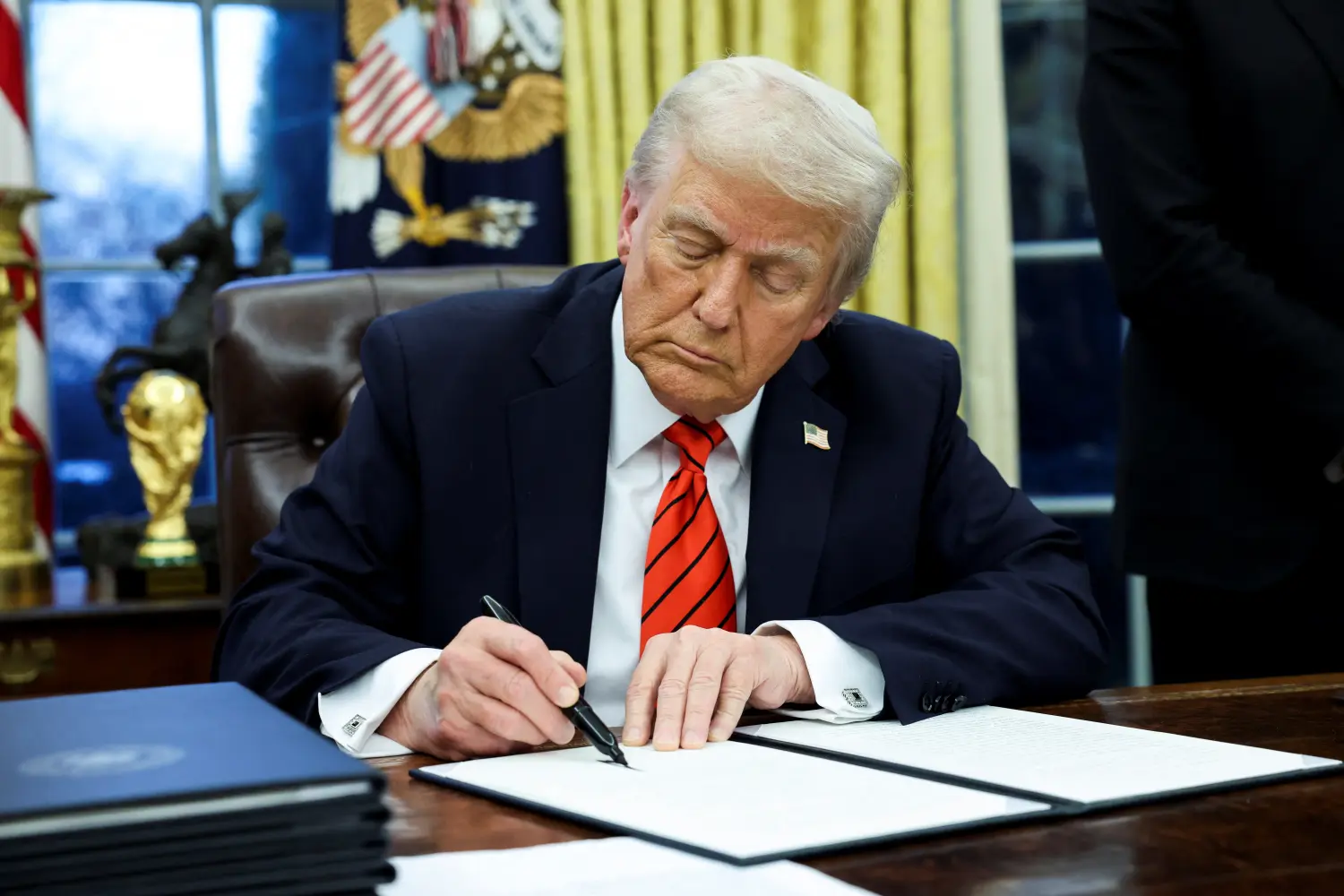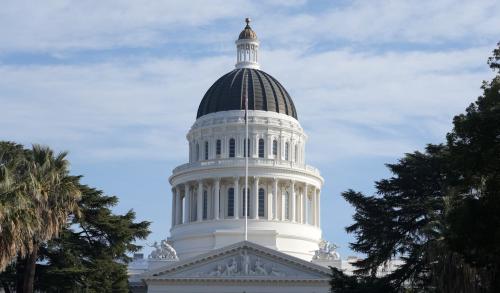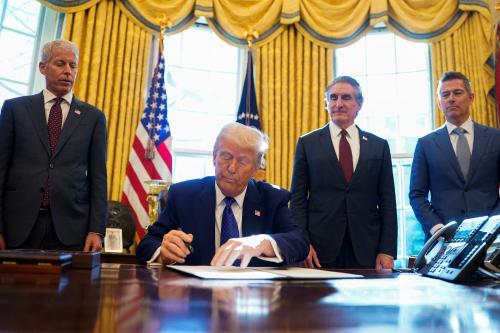President Trump regained control of the executive branch on January 20, 2025, and initiated a sweeping effort to remove many of the Biden administration’s executive actions. Trump has indicated that his rollback of Biden-era actions, in addition to novel deregulatory steps, are likely to continue throughout his second term.
The Brookings Regulatory Tracker (“Reg Tracker”) was developed during the first Trump administration to track deregulatory actions and continued tracking executive branch activities throughout the Biden presidency. We recently relaunched the Reg Tracker with renewed focus on the deregulatory actions of the second Trump administration.
Drawing on experience of tracking regulatory actions across two administrations, in this brief we highlight the mechanisms by which Trump can pursue his deregulatory agenda and the likely targets of these actions. Notably, this review covers only the formal mechanisms of deregulating and not any measures that would, for instance, reduce enforcement of regulations through budget or staff cuts.
What can Trump do to overturn, nullify, or rescind Biden regulations?
The Trump administration has several options to remove the Biden administration’s key regulations. These options vary depending on the rule’s status in the rulemaking process and in the time they take to implement. “Overturning” a rule typically implies a judicial decision or action; “nullifying” a rule typically implies congressional action; and “rescinding” a rule implies executive action.
New presidents usually issue a regulatory moratorium upon taking office. On January 20, 2025, the Trump administration released a regulatory moratorium titled “Regulatory freeze pending review.” This halted all rulemaking processes, including any rules under development and in the proposal stages. This pause allows the new administration to decide which rules to move forward with and which to discard. Nearly all recent administrations issued regulatory moratoriums when the incoming president was of a different party, including the Reagan, Clinton, George W. Bush, Obama, Trump, and Biden administrations.
Trump’s regulatory freeze also directed agencies to withdraw any unpublished rules submitted to the Office of the Federal Register (OFR). Agencies must submit all finalized rules to the OFR to be published in the Federal Register. However, the OFR does not publish a rule immediately; it holds the rule for “confidential processing” and then files the rule for “public inspection” where the document is made available to the public on the Federal Register. During the period of confidential processing, which usually lasts 3-4 business days, OFR generally allows agencies to withdraw rules. Case law has also upheld agencies’ ability to withdraw a rule before it is published in the Federal Register. Rules that have been finalized and published in the Federal Register, however, must be rescinded through formal and time-consuming regulatory processes.
The Trump administration has several options to remove or stall such finalized rules initiated by the Biden administration including rescinding and replacing the rule, encouraging Congress to use the Congressional Review Act (CRA) to nullify a rule, suspending or delaying a rule’s effective date, and requesting an abeyance to halt litigation. These options are detailed below.
Rescinding and replacing a rule
Under the Administrative Procedure Act (APA), the law that requires all agencies to follow specific procedures and processes when issuing regulations, administrations must follow the notice-and-comment procedures when amending regulations. This process generally requires agencies to publish a “notice of proposed rulemaking” in the Federal Register, allow interested parties to comment on the proposed rulemaking, and, after reading and considering those comments, publish the final rule in the Federal Register. This process typically takes around a year to complete and, in most cases, the final rule becomes effective at least 30 days after its publication.
Under the APA, the definition of “rulemaking” is the “process for formulating, amending, or repealing a rule.” Therefore, the incoming Trump administration must undergo the same notice-and-comment rulemaking procedures outlined in the APA to rescind and replace a finalized and published Biden administration rule.
Congressional Review Act
The Congressional Review Act (CRA) is a Congressional tool to nullify recently finalized regulations. The CRA provides Congress with procedures to consider legislation to nullify rules and requires executive agencies to notify Congress when issuing rules. The CRA allows Congress to file a “joint resolution of disapproval” over any final rule within 60 days of continuous session after an agency submitted the rule to Congress. If a joint resolution of disapproval for a rule passes both houses of Congress with a simple majority1 and is signed by the President (or Congress overrides a veto), the rule, in its entirety, cannot go into effect and will “be treated as though it had never been in effect.” In addition, if a joint resolution of disapproval is signed by the President, the agency cannot issue a rule that is “substantially the same” as the nullified rule.
The CRA is typically used during times of presidential transition because a president would likely veto a joint resolution of disapproval that targets a rule their own administration issued (and Congressional override of such a veto is exceedingly rare). During the first Trump administration and the 115th Congress, shortly after Trump took office in his first term, 16 rules were nullified using the CRA. Under the Biden administration and the 117th Congress, only three rules were nullified using the CRA.
Section 801(d) of the CRA, called the “lookback” mechanism, allows Congress to review a rule in the next session if it was submitted with fewer than 60 Senate session days or 60 House legislative days before the session ends. If any rules were submitted fewer than 60 working days before the session ends, for the purposes of Congressional review under the CRA they are treated as though they had been submitted to Congress and published in the Federal Register on the fifteenth working day of the new Congress. Thus, the new Congress has a 60-day window to review those rules following the fifteenth day.2
For the 119th Congress and the incoming Trump administration, any rules the Biden administration submitted to Congress and published in the Federal Register after August 16, 2024, are subject to the “lookback” mechanism of the CRA.
Suspending or delaying a rule’s effective date
Agencies can delay or suspend the effective date of rules that have been finalized and published in the Federal Register but have not taken effect. However, courts have generally held that suspending the effective date of a rule is equivalent to an amendment or repeal of a rule, which requires agencies to undergo the notice-and-comment procedures.
While rules can be delayed to allow agencies to reconsider them, agencies are generally not permitted to postpone a rule indefinitely except under limited circumstances. Agencies can avoid going through the notice-and-comment procedures when delaying a rule’s effective date through two main exceptions:
- The “good cause” exemption: Section 553 of the APA allows agencies to issue final rules without a proposal when an agency finds for “good cause” that the notice-and-comment public procedure is “impractical, unnecessary, or contrary to the public interest.” For the same reasons, agencies can publish a final rule without the standard 30-day period between publication and a rule’s effective date. Agencies have previously justified delaying the effective date of rules using the “good cause” exemption, arguing that the delay was supported by good cause, or in other words, it is impractical, unnecessary, or contrary to the public interest to follow the notice-and-comment procedure to delay the effective date of a rule.
- Section 705: Section 705 of the APA permits agencies to delay a rule’s effective date without providing the opportunity for public comments if the rule is pending judicial review and “an agency finds that justice so requires.” This allows agencies to retain the status quo as litigation proceeds.
For example, to give the agency more time to consider comments, the Obama administration’s Department of Health and Human Services used the “good cause” exemption to delay the effective date of a Bush administration rule.
Most invocations of the “good cause” exemption during a regulatory moratorium to delay the effective date of a rule are not reviewed by the courts. However, the Second Circuit Court of Appeals invalidated a 2001 Department of Energy rule delaying the effective date of efficiency standards. The Trump administration will likely delay the effective dates of the Biden administration’s rules through both notice-and-comment regulatory procedures and through the exceptions described above. Delaying the effective date of a rule simply buys the administration more time to remove the rule through other means.
Requesting an abeyance for rules facing litigation in the courts
For final Biden administration rules facing litigation in the courts, the Trump administration can request abeyances in court, which are “court orders that put off briefing, argument, and decision in the pending case.” Abeyances are typically granted to allow the rulemaking process to unfold, saving judicial resources, particularly if a new rule would moot the issues in a pending case.
Abeyances are important for new administrations looking to rescind and replace rules subject to ongoing litigation. For finalized Biden rules facing litigation, it benefits the Trump administration to ensure that a pending case remains undecided. This gives the administration time to issue a new rule and avoid the possibility that the courts uphold the former administration’s rule. For instance, if a court determines that a rule is within the agency’s statutory authority, it prevents an agency from adopting a conflicting interpretation in a new rule; abeyances prevent the new administration’s agency from this potentially unfavorable result by halting any ongoing litigation in the courts.
Trump used abeyances in his first term and will likely do the same in his second term. During Trump’s first term, his administration submitted a motion to hold a case in abeyance for litigation against the Obama administration’s Clean Power Plan rule. This rule sought to reduce carbon pollution from power plants. On April 4, 2017, the Environmental Protection Agency (EPA) submitted a motion to hold the case in abeyance after the Supreme Court issued a stay for the rule. The abeyance extended the Supreme Court’s stay, allowing the administration to rescind and attempt to replace this rule.3 Similarly to suspending or delaying a rule’s effective date, abeyances buy an administration more time but cannot permanently remove a rule without other action.
What rules will Trump likely target?
In the tables below, we list rules and information directly from the Brookings Regulatory Tracker (“Reg Tracker”). The Reg Tracker is a curated, non-exhaustive database of important federal regulations, executive orders, and agency guidance. The database tracks significant regulations through the regulatory process within and across administrations, stretching as far back as Obama-era rules (see here for a detailed explanation of the Reg Tracker). The Reg Tracker includes regulations that receive significant media attention, rules subject to significant litigation, rules that directly roll back a rule from a previous administration, or other rules deemed particularly important based on Brookings Center on Regulation and Markets staff judgement. In the tables below, we cover Reg Tracker rules from the Biden-era, sorted into five different tables based on how the Trump administration could remove the rule. We place rules more likely to be removed higher within the table.
Table 1 includes rules that the Trump administration could remove by rescinding and replacing them through the typical regulatory process and not subject to a potential joint resolution of disapproval under the CRA. This includes rules in the Reg Tracker initially proposed by the Biden administration and finalized before the CRA lookback window cutoff date of August 16, 2024. The table also excludes rules that are subject to ongoing litigation.
Table 2 covers rules that could be nullified by a joint resolution of disapproval under the CRA. Based on the last day of the 118th Congress and the official Senate and House calendars, this places the lookback window cutoff date at August 16. This means that any regulation finalized and submitted to Congress after this date could be nullified by a joint resolution of disapproval passed by the 119th Congress and signed by President Trump. This table contains all rules in the Reg Tracker finalized by the Biden administration and submitted to Congress after August 16, 2024.
Table 3 includes rules for which the Trump administration could delay the effective date. This includes rules from the Reg Tracker that were finalized by the Biden administration but have an effective date after the Trump administration assumed office on January 20, 2025. The rules in this table overlap significantly with the second table (rules subject to CRA joint resolution). We include both tables because it is much easier for an administration to temporarily delay a rule’s effective date compared to passing a joint resolution of disapproval under the CRA.
Table 4 includes all rules in the Reg Tracker proposed and finalized by the Biden administration that are subject to pending litigation, making them a target for the Trump administration to ask for a motion of abeyance. Abeyances buy more time for the administration to rescind and replace the rule before the courts make a ruling.
Table 5 includes all unfinalized rules proposed by the Biden administration documented in the Reg Tracker. These rules are subject to Trump’s regulatory freeze. The Trump administration can choose which of these rules to move forward with and which to discard. These rules will be the easiest target for deregulatory efforts.
Within each table, we placed rules most likely to be removed by the Trump administration (or Congress through the CRA) higher up within the table. We then go into depth and highlight some specific rules that will likely be removed underneath each table. While there is significant uncertainty regarding which regulations the Trump administration will prioritize, we used the following criteria:
- The extent to which the regulation is related to a major theme of the Republican Party Platform.
- If Trump or a cabinet member has publicly disapproved of the regulation.
- The first Trump administration targeted a related rule for repeal.
Major themes from the Trump administration relevant to the regulations we track in the Reg Tracker include:
- Immigration and border security: The platform emphasizes stricter border security and tighter immigration policy.
- Energy and Environment: The platform embraces fossil fuels and skepticism of climate change mitigation measures.
- Trade: The platform embraces tariffs and protectionist policy.
- Gun control: The platform emphasizes relaxed gun control regulation.
- Reinstating deregulation from the previous Trump administration: The platform promises a return to the permissive regulatory regime from Trump’s first term.
Schedule F civil servant reclassification
Near the end of Trump’s first term, his administration released the “Executive Order on Creating Schedule F in the Excepted Service.” This executive order directed agencies to reclassify civil servants in the competitive service with policy-related jobs to a new class of workers called Schedule F, in the excepted service. This would strip some procedural protections for civil servants, making it easier to remove them.
To protect the federal workforce, the Biden administration issued Executive Order (EO) 14003, which revoked Trump’s Schedule F EO. The Biden administration’s Office of Personnel Management (OPM) later released a rule on April 9, 2024, that makes it difficult for the second Trump administration to reclassify civil servants. The rule clarifies that employees in the competitive service cannot be involuntarily removed from the competitive service and confirms that the excepted service is not intended for civil servants.
One of the first executive orders that President Trump signed on January 20, 2025, included the executive order “Restoring Accountability to Policy-Influencing Positions Within the Federal Workforce.” This executive order reinstates Trump’s Schedule F EO, with some additional changes such as changing the name of the “Schedule F” classification to the “Schedule Policy/Career” classification and adding a section that states that reclassified workers are not required to support the policies they implement but failing to administer them is grounds for dismissal. The EO also directs the OPM to amend and rescind the Biden administration’s rule and issue guidance about additional categories of positions that executive departments and agencies should consider rescheduling to Schedule Policy/Career. Given this EO, we expect that the OPM will soon initiate rulemaking procedures to rescind and replace the Biden administration’s rule to protect civil servants.
Methane waste emissions charge
The Inflation Reduction Act (IRA) amended the Clean Air Act (CAA) to add a section that directs the EPA to implement a Waste Emissions Charge (WEC) on methane emissions from certain oil and gas facilities. On November 18, 2024, the Biden administration finalized regulations that would implement this program. The regulation would charge natural gas and petroleum facilities that emit more than 25,000 metric tons of CO2-equivalent greenhouse gas emissions annually and with methane intensity beyond industry-specific thresholds defined in the CAA. For 2024 reported emissions, the charge starts at $900 per metric ton then increases to $1,200 per metric ton in 2025 and finally reaches $1,500 per metric ton from 2026 onwards.
Based on previous attempts to repeal the IRA, it appears that this program will likely be targeted by a Republican trifecta. The rule has faced opposition from the oil and gas industry. In addition, a group of 55 House Republicans described the EPA’s implementation of this rule as “unworkable.” The program that this rule implements, the Methane Emissions Reduction Program, faced three potential repeals from bills in the 118th Congress (H.R.1, H.R.1023, and H.R.1141), two of which passed the House (H.R.1 and H.R.1023). Unlike some other provisions of the IRA, the WEC program does not benefit Republican districts more than Democratic districts. The WEC emission charge will require Congress to pass legislation for a full repeal. However, rescinding the rule implementing the WEC would buy more time. Additionally, given that this rule’s finalization date falls within the CRA lookback window, it is likely that this rule will face challenges either in Congress or from the Trump administration.
IRA’s advanced manufacturing production tax credit rules
Section 45X of the IRA created the advanced manufacturing production tax credit for clean energy manufacturers in the U.S. This tax credit is for manufacturers of solar energy components, wind energy components, battery components, inverters, and critical minerals. The Section 45X credits are production subsidies, which means that they are calculated based on the amount a firm produces. The Biden administration finalized a rule on October 28, 2024, that implements Section 45X of the IRA and provides guidance on the tax credits. The rule provides detailed guidance on calculating credit amounts, qualifying components and manufacturing processes, domestic production criteria, treatment of related-party sales, eligibility for production subsidies, credit transfers, and leniency for vertically integrated firms. The rule also allows for subcomponents and materials to be produced outside of the U.S., which was previously ambiguous.
This tax credit has driven investments in clean energy infrastructure and manufacturing, which are concentrated in Republican districts and states, making it more difficult for the Trump administration to undo the entire program. However, the Trump administration could target this rule to roll back some of the leniencies the Biden administration included, such as allowing for subcomponents and materials to be produced outside of the U.S. The Trump administration could pressure Congress to nullify this Biden regulation and seek to drive down the costs of this tax credit program by limiting eligibility. During the 118th Congress, U.S. Representatives John Moolenaar (R-MI) and Jared Golden (D-ME) introduced a joint resolution of disapproval to block the implementation of this rule during the 118th Congress and could do so again in the 119th Congress, this time with Republican control of the Senate.
Several reforms to this tax credit have been introduced in Congress to limit the ability of foreign-owned firms from receiving the credit. The Protecting Advanced Manufacturing Act would exclude companies from receiving the credit if 10% or more of their ownership is based in or subject to the laws of foreign adversarial countries such as China and Russia. In addition, the American Tax Dollars for American Solar Manufacturing Act would disallow this credit for goods produced by foreign entities of concern, including China, Iran, Russia, and North Korea.
The Trump administration has already taken aim at Biden’s climate policies in his executive order (EO), “Unleashing American Energy.” Section 7 of this EO directs agencies to “immediately pause the disbursement of funds appropriated through the Inflation Reduction Act of 2022,” indicating that this rule could likely face scrutiny under the current Trump administration.
FTC rule on “Junk Fees”
The Biden administration’s Federal Trade Commission (FTC) finalized a rule on January 10, 2025, that regulates event ticketing and hotel pricing, requiring vendors to show up-front prices and get rid of “junk fees” or extra charges that are hidden or unexpected. The initial proposal regulated junk fees more broadly, but the finalized rule narrowed the scope to only regulate junk fees of hotels and event ticketing services. This rule is set to take effect on May 12, 2025, making it susceptible to a delaying of the rule’s effective date.
This rule has broad support from both Democrats and Republicans, making it possible that the Trump administration lets this rule take effect. In fact, two bills targeting junk fees, the No Hidden FEES Act and the TICKET Act, passed in the Republican-controlled House during the 118th Congress. Therefore, a CRA resolution to nullify this rule may be unlikely.
However, the Trump administration may push back the effective date to consider more comments or amend the rule. Trump’s pick for the FTC Chair, Andrew Ferguson, was the only dissenting voice on the commission when it finalized this rule. While his objection was based on politics, arguing that the Trump administration “should have the opportunity to decide whether to adopt rules that it, not the Biden-Harris FTC, will be called upon to enforce,” it is possible that Ferguson’s FTC may pursue delaying this rule to decide whether or not to adopt it.
Clean Power Plan – New source performance standards for power plants
The Obama administration introduced the Clean Power Plan (CPP) to set emissions reduction requirements for fossil fuel-powered power plants. The rule faced litigation in the lower courts, and the Supreme Court temporarily blocked the rule from going into effect in February 2016. The Trump administration later filed a motion for an abeyance of the case in the U.S. Court of Appeals for the District of Columbia Circuit and subsequently rescinded the Obama administration’s rule.
The Trump administration followed rescission of the CPP introduced the Affordable Clean Energy (ACE) rule, which set forth less stringent emissions standards for coal-fired power plants. This rule faced litigation in the D.C. Circuit Court by the American Lung Association, along with 23 states and seven cities. The circuit court ruled in favor of the American Lung Association, vacating the ACE and reimplementing the CPP. Later, in a 2022 ruling, the Supreme Court voted 6-3 to strike down the CPP, arguing that the EPA did not have the authority to regulate power plant emissions using a cap-and-trade system. This ruling established the major questions doctrine, which states that agencies do not have the authority to make decisions of “vast economic and political significance” unless clearly authorized by Congress. The ruling implies that the EPA cannot regulate power plant emissions at the grid level to enable “generation-shifting measures” but allowed them to regulate them at the individual power plant level.
The Biden administration, in response to the ruling, finalized a rule in May 2024 that sets emissions reduction requirements at the individual power plant level for coal and natural gas-fired plants. This rule sets several emissions reductions standards and requires coal plants to either retire before 2032, cut emissions by 16% by 2030 and retire by 2039, or reduce emissions by 90% by 2032 to continue operating through or beyond 2039.4 The rule has faced several challenges in the courts but was temporarily upheld by the D.C. Circuit Court while legal challenges continue. In response to emergency appeals by the plaintiffs, the Supreme Court denied granting a stay for this rule.
The incoming Trump administration will likely request an abeyance for ongoing litigation to ensure no ruling is reached while it works to rescind and repeal the Biden administration’s rule, given its previous actions on the Clean Power Plan. The Biden administration’s rule was a notable divergence from the Trump administration’s ACE plan, implementing strict emission reduction requirements for coal-fired power plants.
Banning the sale of ghost guns
“Ghost guns” are untraceable firearms without serial numbers, often bought in “buy build shoot” kits that allow the buyer to assemble the gun’s separate parts and avoid a background check. On April 26, 2022, the Biden administration finalized a rule that would require “buy build shoot” kits have serial numbers and require background checks for buyers. The rule would also require gun dealers to add serial numbers to any ghost guns that come into their possession.
This rule has faced heavy litigation in the courts from part manufacturers, gun owners, and gun rights groups. This rule was challenged in a U.S. District Court in Texas, which resulted in the court striking down the regulation nationwide in July 2023. The Biden administration sought an appeal to the ruling in the U.S. Court of Appeals for the Fifth Circuit, but the court refused to block key aspects of the District Court’s ruling. U.S. Solicitor General Elizabeth B. Prelogar asked the Supreme Court to intervene and keep the regulations in place while the challenges continue in the courts. The Supreme Court reinstated this rule temporarily while challenges in the courts continue. In October 2024, the Supreme Court heard oral arguments in the lawsuits challenging this rule and signaled that they would likely uphold the Biden administration’s rule.
Given that the Supreme Court has not issued a ruling on the lawsuits challenging this rule, it is likely that the Trump administration will request an abeyance on the lawsuits to reconsider the regulations. If the Supreme Court were to uphold this rule, it would make it more difficult for the Trump administration to rewrite these regulations.
Modernizing the Au Pair Program
The Au Pair Program is a cultural exchange program that allows foreign nationals to live under a J-1 visa with an American family for childcare assistance, education, and engagement in cultural activities. Host families provide au pairs with room and board and a weekly stipend of $195.75. Host families are responsible for setting the weekly work schedule of au pairs, which is limited to 45 hours a week and no more than 10 hours a day. For au pairs that are pursuing education in the U.S., there is an EduCare option of the program. The EduCare option has a limit of 30 hours of weekly childcare to allow more time for study.
The Biden administration released a proposed rule in October 2023 to make significant changes to the Au Pair Program. These proposed changes include reducing the maximum workweek hours from 45 to 40 unless the host family pays au pairs 150% wages for additional hours beyond 40, which is permitted only under “limited exigent circumstances.” The rule also proposes to adjust the weekly stipend to vary depending on the cost of living and minimum wage requirements of the host family’s state. The proposal would replace the EduCare option with a part-time option limited to 24 to 31 hours of work each week. The proposed rule would also change the matching process for host families, requiring orientation and creating operating procedures for rematching au pairs with new host families.
This proposal received nearly 12,000 comments, some of which are from au pairs supporting the proposed changes, but many more comments are from families opposing the changes. Many host families commented that the proposed changes would make it too costly to participate in the program and would force many families to drop out of the program. The proposed rule would make it more costly for families to hire au pairs to help with childcare, an already costly part of most family’s budgets, with annual costs per child ranging from $4,810 to $15,417 in 2018. The International Au Pair Association listed the potential negative effects of implementing the proposed changes, such as shifting the program from a cultural exchange to a labor program and increasing complexity in administration and oversight. Given the number of comments, the Department of State plans to publish a new Notice of Proposed Rulemaking to consider additional comments.
While President Trump has not said much about child care, his administration has been strict about immigration. The Trump administration could freeze this regulation and possibly alter the program to make it more difficult for foreigners to apply for a J-1 visa to become an au pair. Since this rule has not been finalized, the Trump administration can alter the rule proposal to include stricter changes in the visa application process. The Trump administration has already taken several actions to restrict immigration, including an executive order that instructs the Department of Homeland Security and Department of State to implement stricter “enhanced vetting” for visa applicants and those already in the country. The Trump administration might make it harder for au pairs to get visas in the U.S. while also pursuing altering this proposed regulation.
Conclusion
The Trump administration’s ability to carry out its deregulatory agenda will depend on a combination of legal, procedural, and political factors. While Congress will play a crucial role in efforts to nullify significant regulations through the CRA, most of the responsibility will fall to the executive agencies to deregulate through the slower process of delaying, withdrawing, and replacing rules. The courts will further complicate the Trump administration’s goals, particularly in cases where they have already ruled on key regulatory issues. As these efforts unfold, the Brookings Regulatory Tracker will continue to monitor developments, offering a detailed view of how the Trump administration’s regulatory priorities take shape over the course of the next 4 years.
-
Footnotes
- A joint resolution of disapproval cannot be filibustered if the resolution is introduced on the Senate floor using “fast-track procedures.” CRA fast-track procedures allow a simple majority to proceed with a resolution of disapproval, limiting debate to 10 hours and prohibiting amendments after its introduction. Joint resolutions of disapproval require an immediate vote without the need of cloture under fast-track procedures.
- For the 119th Congress, the fifteenth session day of the House of Representatives was January 31, 2025, and the fifteenth session day of the Senate was January 24, 2025.
- The Trump administration’s rescindment and replacement for the Clean Power Plan, named the Affordable Clean Energy rule, was eventually struck down in court, vacating the Trump administration’s rule and reverting back to the Clean Power Plan. The Supreme Court later struck down the Clean Power Plan, stating that the EPA’s actions were not “within the authority granted to the Agency in…the Clean Air Act.” For more information on the Clean Power Plan, see the “Clean Power Plan” entry in the Reg Tracker.
- Coal-fired power plants reducing emissions by 16% are expected to achieve this reduction by requiring 40% natural gas co-firing. Coal-fired plants operating through or beyond 2039 are expected to achieve 90% emissions reductions using carbon capture and sequestration under the finalized rule.
The Brookings Institution is committed to quality, independence, and impact.
We are supported by a diverse array of funders. In line with our values and policies, each Brookings publication represents the sole views of its author(s).







